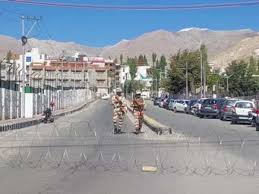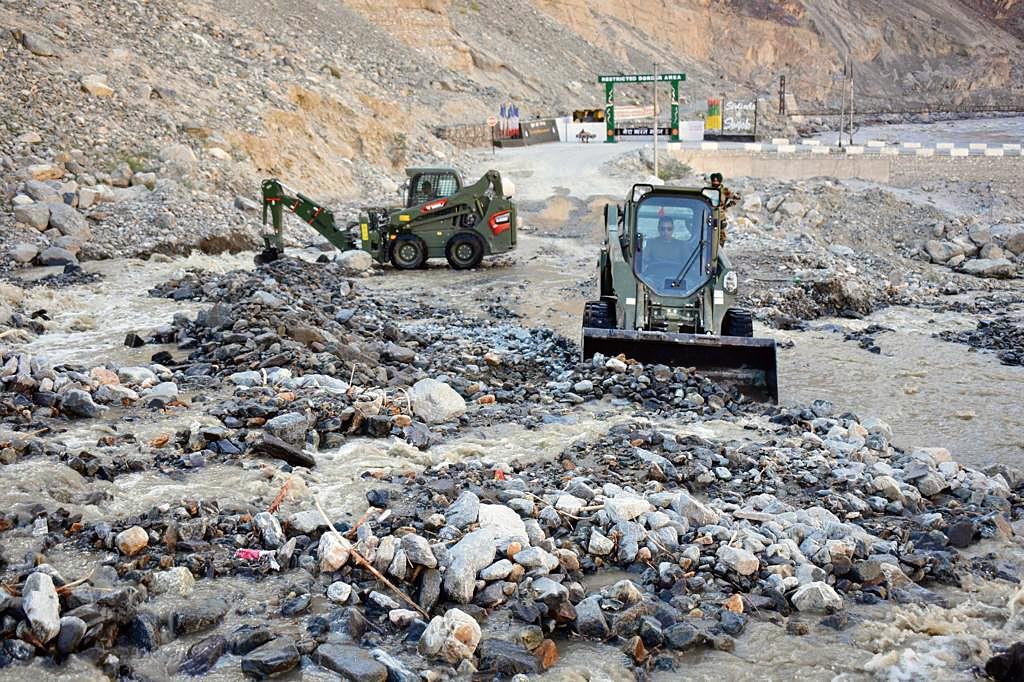Leh Under Siege: Curfew, Internet Blackout, and the Statehood Struggle in Ladakh
By: Javid Amin | 30 September 2025
Ladakh’s Moment of Reckoning
On September 30, 2025, Leh witnessed a partial easing of curfew restrictions, with authorities announcing a 4-hour relaxation window. Yet the digital blackout—complete suspension of mobile internet—remains firmly in place. The trigger? Violent protests over Ladakh’s demand for statehood and the controversial National Security Act (NSA) detention of activist Sonam Wangchuk.
For India’s youngest Union Territory, this is more than a law-and-order crisis. It is a litmus test for democracy, governance, and reform in one of the most strategically sensitive and culturally distinct regions of the country.
The curfew and blackout are symptoms of a deeper malaise: alienation, economic stagnation, and governance fatigue. Ladakhis, once hopeful that Union Territory (UT) status in 2019 would empower them, now feel sidelined, unrepresented, and digitally silenced.
This feature explores the crisis in its entirety—factually, analytically, and reformistically.
From UT Joy to Statehood Anguish
When Ladakh was carved out as a Union Territory in August 2019, many celebrated the historic move. For decades, Ladakhi leaders had demanded separation from Jammu and Kashmir, citing cultural distinctiveness, underdevelopment, and neglect from Srinagar.
But five years later, optimism has curdled into frustration. UT status has not delivered:
-
No Legislative Assembly: Unlike Delhi or Puducherry, Ladakh has no elected assembly. All power rests with the Lieutenant Governor (LG) appointed by Delhi.
-
Bureaucratic Centralization: Key decisions—from land use to budget allocations—are taken without meaningful local consultation.
-
Democratic Deficit: Ladakhi leaders argue that without statehood or Sixth Schedule protections, Ladakhis are politically voiceless.
The demand for full-fledged statehood is not just symbolic—it’s a call for constitutional safeguards, legislative autonomy, and protection of fragile ecology and culture.
The Spark—Sonam Wangchuk’s Detention
The detention of renowned environmentalist and reformist Sonam Wangchuk under the NSA became the flashpoint.
Wangchuk has long championed sustainable development in Ladakh, gaining global recognition for his “ice stupa” innovation. But his activism increasingly turned political—criticizing unregulated mining, unchecked tourism, and the absence of constitutional safeguards for locals.
His arrest was seen as:
-
A crackdown on dissent: Symbolizing intolerance toward peaceful protest.
-
A catalyst for anger: Transforming latent frustration into street protests.
-
A governance miscalculation: Worsening rather than diffusing tensions.
For many Ladakhis, Wangchuk’s detention under a stringent law meant for threats to national security was disproportionate, unnecessary, and provocative.
The Digital Blackout—Silencing a Region
The internet shutdown across Leh and adjoining areas adds another layer of complexity. While authorities justify it on security grounds, the impact is profound:
-
Economic Paralysis: Tourism operators, traders, and small businesses lose online bookings, payments, and connectivity.
-
Educational Setback: Students preparing for competitive exams or relying on digital classes are stranded.
-
Civil Liberties: Citizens cannot communicate, journalists cannot report freely, and civil society cannot coordinate.
-
Psychological Impact: The uncertainty of a digital vacuum breeds anxiety, misinformation, and mistrust.
India has faced global criticism for its frequent internet shutdowns, and Ladakh’s blackout reinforces questions about proportionality, accountability, and democratic rights.
The Statehood Protests—Demand for Dignity
The current protests are not spontaneous—they are the culmination of years of agitation by civil society, political groups, and student bodies. Core demands include:
-
Statehood for Ladakh to ensure legislative representation.
-
Sixth Schedule protections for tribal and indigenous rights.
-
Transparent governance with accountability mechanisms.
-
Sustainable development policies that balance ecology and economy.
The curfew reflects the administration’s law-and-order lens, but Ladakhis view their struggle as existential—about land, livelihood, and legacy.
Economic Fallout of Curfew & Blackout
01. Tourism: A Silent Valley
Ladakh’s economy leans heavily on tourism. September is typically peak season for domestic travelers. The curfew and blackout have caused:
-
Mass cancellations of hotel bookings.
-
Losses for guides, drivers, and homestays.
-
Erosion of Ladakh’s image as a safe travel destination.
02. Trade & Transport
-
Disruption of supply chains through the Srinagar-Leh and Manali-Leh highways.
-
Increased costs for essentials due to scarcity.
-
Hampered e-commerce and logistics.
03. Local Businesses
-
Digital payments frozen.
-
Cold storage and perishable goods (like apricots, pashmina wool trade) affected.
-
Handicraft exports delayed.
Social & Educational Impact
-
Schools & Colleges: Remain shut or partially functional under curfew. Students preparing for exams lose access to online study material.
-
Healthcare: Patients struggle with delayed referrals to Srinagar or Chandigarh due to curfew restrictions. Telemedicine becomes impossible without internet.
-
Civil Society: NGOs and local cooperatives cannot coordinate flood relief or cultural initiatives.
Governance Under the Lens
Critics argue the Leh curfew crisis exposes the structural flaws of Ladakh’s UT governance model:
-
Over-centralization: Decisions taken in Delhi or by LG without local input.
-
Security-first approach: Administration treats civil unrest as a policing issue, not a political dialogue.
-
Accountability gaps: No elected assembly to question, debate, or hold bureaucrats responsible.
This fuels the narrative that Ladakhis are subjects, not stakeholders, in their own governance.
Reformist Lens—Pathways Forward
The crisis can become an opportunity if addressed reformistically. Solutions include:
-
Statehood with Constitutional Safeguards: Grant Ladakh a legislative assembly with powers over land, culture, and resources.
-
Sixth Schedule Inclusion: Protect indigenous rights and prevent exploitative development.
-
Digital Rights Charter: Create proportional guidelines for internet shutdowns, ensuring transparency and judicial oversight.
-
Participatory Governance: Institutionalize community consultation in policy-making.
-
Balanced Development: Promote eco-tourism, renewable energy, and sustainable infrastructure rather than exploitative mega-projects.
National & Global Implications
Ladakh is not just another region—it’s a strategic frontier with China and Pakistan. Its stability is vital for:
-
National Security: Discontent risks internal fragility in a border zone.
-
International Image: Frequent shutdowns and curfews undermine India’s democratic credentials.
-
Environmental Stewardship: Ladakh is an ecological hotspot whose mismanagement has global climate consequences.
Bottom-Line: From Curfew to Consensus
The curfew relaxation in Leh is a tactical step, but without structural reform, it risks being cosmetic. Internet shutdowns may temporarily silence voices, but they cannot erase aspirations.
Ladakhis are not asking for privileges—they are asking for participation, protection, and dignity. To treat this as merely a law-and-order problem is to misread a democratic plea as a disturbance.
The road ahead requires courage—not to impose, but to listen; not to centralize, but to share power. Ladakh’s statehood struggle is not a rebellion—it is a reminder that democracy must reach the mountains, not bypass them.



